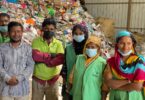This deep dive article is content that would normally only be available to subscribers. Sign up for a four-week free trial to see what you have been missing
LanzaTech, a U.S.-based scale-up, is creating a circular economy system that turns pollution from steel mills and other greenhouse gases into household cleaners, laundry detergent, sustainable aviation fuel, perfume and more. Large corporates participating in the ecosystem system include Migros, L’Oreal, Total, British Airways, Shell, Unilever, Coty and ArcelorMittal.
By recycling carbon from industrial off-gases; syngas generated from biomass resources such as municipal solid waste, organic industrial waste or agricultural waste; and reformed biogas, LanzaTech says it can displace 30% of crude oil used today and reduce global CO2 emissions by as much as 10%.
Its patented gas fermentation technology has already stopped over 100,000 tons of CO2 from being emitted into the atmosphere, the equivalent to over 250 million miles driven by average passenger vehicles, according to the company. The waste carbon emissions are converted into fuels, chemicals and everyday goods, that would otherwise come from fossil resources.
“We are producing a building block of the future,” says Freya Burton, LanzaTech’s Chief Sustainability and People Officer.
LanzaTech’s circular economy system is yet another example of how corporates are teaming with young, innovative companies to help solve the United Nations Sustainable Development Goals.
In LanzaTech’s case the partnerships involve shifts in production and creating newly configured supply chains. “When you dream big and connect different industries, you can create a lot of value,” says Coty Senior Vice-President Research Development Thierry Moliere.
A Science Game Changer
LanzaTech is a member of the World Economic Forum’s Global Innovators community. Its CEO, Jennifer Holmgren, was presented the prestigious Edison award on April 23. Every year, the Edison Awards honors one or more individuals who have distinguished themselves by making a significant and lasting contribution to the world of innovation. Past recipients include Steve Jobs, Elon Musk and John Chambers, among others. The Edison Awards also awarded LanzaTech’s “CarbonSmart for a Blue-Sky Future” technology its Science Game Changer award.
On April 28th the company filed its 1000th patent. Each of the patents contributes to a platform which enables the use of gas feedstocks for the production of a large variety of sustainable fuels, chemicals, and products, with an eye to covering use of the feedstocks of the future, as countries and industries begin their own energy transitions.
Recycled carbon is a key form of renewable carbon and is essential to eliminating the use of fossil fuels. A recent report published by the Nova Institute and Unilever in April 2021 estimates that demand for fossil-derived chemicals will more than double by 2050. Renewable carbon production will need to increase by a factor of 15 by 2050 to phase-out the use of fossil carbon in consumer products.
LanzaTech is in a good position to step up.
Carbon-Eating Bacteria
The scaleup was started in New Zealand. Two local biologists – Sean Simpson and the late Richard Foster – tried their hand at making biofuels from biomass. Their initial approach didn’t work, and the company went bust. Undeterred, the two used their unemployment checks to fund efforts to create fuel out of something other than fossil fuels, plants, or vegetables. They had a hunch about using bacteria to convert carbon emissions and established LanzaTech in 2005 as a two-man startup in a lab.
After reading about a specific type of bacteria they ordered some and eventually launched a trial with New Zealand’s Glenbrook steel mill. The steel mill’s waste gas was fed to the anaerobic bacteria. “The bacteria ate it, fermented it and made ethanol,” explains Burton.
Think of LanzaTech’s carbon recycling technology like retrofitting a brewery onto an emission source like a steel mill or a landfill site, but instead of using sugars and yeast to make beer, pollution is converted by bacteria to fuels and chemicals, she says.
LanzaTech’s next move was to go to China, to prove that the process could scale. It started by building a demonstration plant in 2009, then built a second, both attached to steel mills. The scaleup built its first commercial site in China in 2018, has since created a second, and a third is under construction. LanzaTech has also attached a plant to a refinery in India and to an ArcelorMittel plant in Belgium that is due to become operational next year. It additionally organized a pilot in Japan to gasify trash from landfills and last November launched a project in India to convert residue from farmer’s fields that is normally burnt, releasing smoke into the atmosphere, into ethanol that can be used for a variety of applications.
The scaleup, which moved its headquarters to the U.S. in 2014, is benefiting from several trends. Factories and the makers of consumer products are under pressure to reduce their carbon footprints and countries who are moving away from fossil fuels don’t want to use valuable land or waste food resources such as sugar cane, corn or beets, to make ethanol. LanzaTech also solves another issue: most companies don’t want to build and operate their own feedstock gas plants, so LanzaTech licenses them the technology and then it connects the makers of the ethanol to the companies that want to turn it into end products, creating new supply chains and new value propositions. Burton calls it “industrial symbiosis.”
Industrial Symbiosis
Over 80 tons of ethanol produced by the Beijing Shougang LanzaTech New Energy Science & Technology, a joint venture between LanzaTech, Shougang Group, a leading Chinese iron and steel producer, Shougang Fund, Dehui group and its New Zealand partner, TangMing, has been shipped to Europe to Switzerland’s largest retail company, Migros. Migros used the ethanol to launch a new range of Migros Plus Oeko Power and Potz cleaning products in its subsidiary Mibelle Group’s portfolio. The ethanol used in the products on sale in Migros supermarkets in Switzerland, used to be made from fermented biomass, such as sugar beet and corn.
Migros’ cleaning products were the first commercial product to use LanzaTech’s technology. Since then, many other commercial products have been made from ethanol produced by LanzaTech plants connected to steel mills and refineries.
For example, through a partnership, LanzaTech, Total and L’Oréal have premiered the world’s first sustainable packaging made from captured and recycled carbon emissions. The conversion process takes place in three steps: LanzaTech captures industrial carbon emissions and converts them into ethanol; Total then uses a dehydration process jointly developed with IFP Axens to convert the ethanol into ethylene before polymerizing it into a polyethylene that has the same technical characteristics as its fossil counterpart; L’Oréal then uses this polyethylene to produce packaging with the same quality and properties as conventional polyethylene.
LanzaTech, in partnership with Indian Oil and the Indian Department of Biotechnology, has also used its carbon-capture technology to turn CO2 pollution into lipids and omega-3 fatty acids, which can be used to make an array of products, from nutritional supplements to fish feed to vegetable oil replacements.
The Sky’s The Limit
Use cases don’t stop there. LanzaJet, a subsidiary of LanzaTech launched in 2020, is building a commercial scale plant in Georgia to produce sustainable aviation fuel (SAF), attracting investments from Shell and British Airways.
The plant in Georgia is due to begin construction this year. It will convert sustainable ethanol (a chemical compound widely blended with petrol to reduce its carbon intensity) into sustainable aviation fuel using a patented chemical process.
The fuel produced at the plant promises to deliver a reduction of more than 70% in greenhouse gas emissions compared to conventional fossil jet fuel, equivalent to taking almost 27,000 petrol or diesel cars off the road each year.
The sustainable aviation fuel produced by LanzaJet is made via the LanzaJet Alcohol to Jet Process, which can use any source of sustainable ethanol, including, but not limited to, ethanol made from non-edible agricultural residues such as wheat straw and recycled pollution. Commercialization of this new type of sustainable aviation fuel has been years in the making, starting with the partnership between LanzaTech and the U.S Department of Energy’s Pacific Northwest National Laboratory.
British Airways said it will purchase SAF from LanzaJet’s U.S. plant to power a number of the airline’s flights from late 2022. The deal also involves LanzaJet conducting early-stage planning for a potential large scale commercial SAF biorefinery in the UK.
How Clean Laundry Could Lean To A Clean Future
LanzaTech recently announced that it is partnering with Unilever and green chemical maker India Glycols to produce a surfactant made from industrial carbon emissions instead of from fossil fuels. Theshift in production uses biotechnologies and a newly configured supply chain between the three partners, who are working together for the first time.
LanzaTech captures waste emissions and turns them into ethanol; India Glycols takes that ethanol and turn it into ethylene oxide, a feedstock to make surfactants. which Unilever then uses in a laundry detergent called OMO.
Typically derived from fossil fuels, surfactants are a critical ingredient for creating the foam and cleaning action of many household cleaning and laundry products, from dish soaps to fabric detergents.
The process marks the first time a surfactant made using captured carbon emissions will come to market in a cleaning product. The new surfactant is being used in limited editions of OMO capsules which were first made available to consumers in China on April 22nd, World Earth Day. And it is just the start, Jonathan Hague, Vice-President Science and Technology, Unilever’s Home Care, said in an interview.
“We have got plans to take this to the next step,” Hague says. What’s more “the versatility of LanzaTech’s technology means that quite a lot of other raw materials could come from this route, so I would expect other innovations beyond the one we did in laundry detergents,” he says.
The partnership is part of Unilever’s Clean Future program, which aims to eliminate fossil-fuel-based chemicals from all Unilever cleaning and laundry products by 2030. “It is a beautiful fit to our ambition,” says Hague. “We are absolutely in lockstep.”
That said, “when you piece together a partnership with a new technology and you want to apply that on a much bigger scale it requires bigger investments and bigger decisions,” says Hague. “The big investments are still ahead of us.”
Eau D’Emissions
Moliere’s job as senior vice-president research development at Coty, a multinational beauty care company, focuses on the intersection of technology, innovation and sustainability. Coty was looking for a new source of ethanol for its fragrances. When it heard about what LanzaTech was doing it signaled interest in a partnership. The tough part was figuring out how to purify LanzaTech’s ethanol used for fine fragrances so there would be no impact on the quality of the end-product. “We were super excited about partnering,” says Moliere. “We decided together to shoot for the moon; we didn’t know where we were going to land but we had a common aspiration.”
Using a new raw material posed challenges so LanzaTech didn’t object to Coty using its own purification process. “They are not territorial,” says Moliere. “We needed batch after batch to have the same high quality.” Coty has added an additional step to achieve the right quality and to have a control mechanism, which re-loops the ethanol through the system if the right quality is not reached. The company says it can begin producing sellable products “within a matter of a few months,” says Moliere. “We are extremely confident in our program,” he says. The last step is to ensure that the Coty supply chain is able to manage ethanol produced with LanzaTech’s technology efficiently. By 2023 Moliere predicts most of the fragrances Coty products will be using it.
The 2022 opening of a major new ArcelorMittal steel plant in Belgium, which will be equipped with LanzaTech’s carbon capture technology, will play a major role in helping Coty scale-up use of the technology and further improve the environmental benefits.
Steeling For Change
ArcelorMittal has been partnering with LanzaTech on various projects since 2013. Small scale pilots convinced the company to do more, says ArcelorMittaal CTO Wim Van der Stricht, leading to the construction of what he says will be the “most impressive” LanzaTech production plant in the world.
This production plant, in Ghent, Belgium, which requires an investment of €165 million, is being built next to the ArcelorMittal steel mill, with the help of a €75 million loan from the European Investment Bank and funding from the European H2020 program and Flemish and Belgian grants.
The industrial-scale demonstration plant will capture flue gases from the blast furnace and biologically convert them into recycled carbon ethanol, the first commercial product of ArcelorMittal’s Carbalyst family of recycled carbon chemicals. The ethanol produced with technology developed by LanzaTech, with whom ArcelorMittal has entered a long-term partnership, can be blended for use as a liquid fuel or used to make products like plastics or fragrances.
Once complete, the plant is expected to produce up to 80 million liters of recycled-carbon ethanol a year, enough to abate 140 tons of CO2 per year, the equivalent of the carbon emissions produced by 100,000 cars during a full year, says Van der Stricht, who focuses on technology strategy, CO2 and circular economy for the steel maker.
He sees lots of potential for LanzaTech’s technology. “The same microbes that produce ethanol can be trained to produce other chemicals,” says Van der Stricht, allowing carbon to be used again and again rather than being emitted into the atmosphere, resulting in carbon neutrality.
“There is a strong link between the steel making and chemical industries,” he says. “The byproduct of one can be used as a feedstock for the other.”
The steel maker’s collaboration with LanzaTech is “a nice example of how open innovation and collaboration can lead to a very nice, hopefully successful project that can help society,” Van der Stricht says.
To access more of The Innovator’s Profits With A Purpose articles click here.
This deep dive article is content that would normally only be available to subscribers. Sign up for a four-week free trial to see what you have been missing







